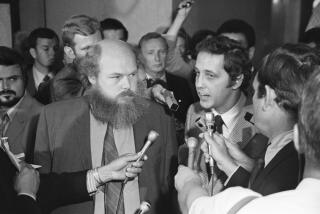George Hedges dies at 57; celebrity lawyer was also a noted archaeologist
- Share via
George Hedges, the Hollywood lawyer to celebrities such as Mel Gibson and Simon Cowell who became a celebrity himself for his discoveries of the fabled ancient city of Ubar and the frankincense trade route in Yemen, died Tuesday at his home in South Pasadena. He was 57 and had been battling melanoma for seven months.
Hedges was “a true scholar” with the “organizational skill to be able to put together the interdisciplinary group” necessary to make the team’s discoveries in the Middle East, said Jet Propulsion Laboratory geologist Ronald Blom, a member of that team.
Hedges had “a combination of energy, vision, ambition and dedication” that made the research possible, Blom said.
As a lawyer, Hedges was “a consummate professional . . . who represented every type of contributor -- studios, talent, producers and directors,” said John Quinn, a partner at Los Angeles’ Quinn Emanuel Urquhart Oliver & Hedges. “He was universally liked and respected. You can’t say that about everybody in the industry. From time to time, egos have been known to get in the way, but never with George.”
Trained in the classics, Hedges retained an interest in archaeology throughout his law career. A 1984 luncheon conversation with filmmaker Nicholas Clapp brought the fabled city of Ubar to his attention. An important center of the frankincense trade 3,000 years before the birth of Christ, Ubar had been unsuccessfully sought by a variety of archaeologists and explorers, and many thought it was mythical.
Hedges and Clapp decided it was real and enlisted JPL scientists Blom and Charles Elachi, who persuaded NASA astronauts to photograph the region of southern Oman where they believed the city would be found. Those photos revealed faint traces of ancient caravan paths packed firmly by the feet of thousands of camels. Several junctions where the routes converged were possible sites of Ubar.
The team enlisted now- retired archaeologist Juris Zarins of Southwest Missouri State University and descended on Oman. On New Year’s Eve 1991, they found preliminary evidence that what is now known as the village of Shisr, in the barren Empty Quarter or Rub’al Khali, was the site of Ubar.
Excavations revealed the presence of an octagonal fort with crenelated towers identical to those described in ancient documents. The fort had inadvertently been constructed over a massive limestone cavern and had collapsed into the cavern during an earthquake, triggering the legend that the city had been destroyed by God because of its greed.
Five years later, the team used similar space imagery of southern Yemen to discover a network of trade routes connecting more than 65 archaeological sites, including a pair of fortresses virtually identical to that discovered at Ubar. Most of the sites were stone caravansaries that guarded portions of the routes used by the camel caravans to transport frankincense from Oman to cultures throughout the Middle East.
Hedges was equally successful as an attorney, earning the title of “California Super Lawyer” from Los Angeles magazine and making the Hollywood Reporter’s Top 100 Power Lawyers list.
One of his favorite cases involved freeing super-agent Ed Limato -- whose clients included Denzel Washington, Gibson, Steve Martin and Richard Gere -- from International Creative Management Inc., overturning a non-compete clause that would have prohibited Limato from continuing in the business.
Hedges also represented director David Lynch, winning a $6.5-million judgment against the French company CiBy 2000, one of the largest “pay or play” judgments ever. Pay or play means that the star or director must be paid even if a film is never released.
He also represented the Academy of Motion Picture Arts & Sciences, the Academy of Television Arts and Sciences, and Fox in various trademark disputes.
Acting pro bono, he also represented Ralph Nader, Harvey Rosenfield and public interest groups before the California Supreme Court in defense of Proposition 103, the auto insurance initiative that rolled back and regulated rates.
Hedges often said that his proudest moments occurred during his 20-year pro bono effort to overturn the death sentence of Adam Miranda, who was convicted of two murders.
But Hedges successfully argued that the prosecution had withheld another man’s confession to one of the murders. Last May, the California Supreme Court agreed, and Miranda’s death sentence was changed to life in prison.
George Reynolds Hedges was born Feb. 26, 1952, in Philadelphia.
He earned his bachelor’s and master’s degrees in the classics at the University of Pennsylvania in 1975 and did a fellowship at the American School of Classical Studies in Athens. He earned his law degree at USC in 1978.
A talented singer, Hedges worked his way through college as a wedding singer. On the archaeological expeditions, Zarins said, “He would bring along his guitar and entertain the Bedouins -- with rock ‘n’ roll, of all things.”
The negotiating skills that marked Hedges’ appearances in the courtroom were also crucial in the field, Zarins and Blom said, particularly in Yemen, where the central government has control only in the cities and exploration required continual negotiation with tribal leaders.
“We essentially always got what we wanted or needed,” Blom said.
After earning his law degree, Hedges clerked for the U.S. District Court before joining Kaplan, Livingston, Goodwin, Berkowitz & Selwin.
In 1988, he founded his own firm, Hedges & Caldwell, and remained there until 1998, when he was recruited by Quinn Emanuel to raise its profile in Hollywood.
Hedges is survived by his wife, the former Christy Susan Shonnard; and two sons, George Shonnard Hedges, a Los Angeles film editor, and Duncan Fox Hedges, a law student at USC.
More to Read
Sign up for Essential California
The most important California stories and recommendations in your inbox every morning.
You may occasionally receive promotional content from the Los Angeles Times.












